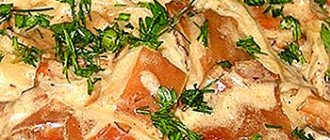The most popular dishes of Ukrainian cuisine. What Ukrainian dishes should you try?
When coming to Kyiv and getting acquainted with its sights, you should not deny yourself the pleasure of eating traditional Ukrainian cuisine.
Of course, any national cuisine reflects the character of the people, their history, and living conditions. And Ukrainian cuisine is the same as the Ukrainians: it is generous, loves everything more and tastier, and does not care at all about the figure :))). Its peculiarity is the widespread use of pork, vegetable oil, tomatoes, “tsybul” (onions), “buryak” (beets), potatoes, cucumbers, cabbage, and wheat flour. Our land is generous and all the freshest and most delicious things fall into the hands of the cook: cereals and flour; pork, beef, lamb, chicken, goose, quail; many varieties of fish - carp, pike, pike perch, trout; vegetables, roots and fruits. For our best dishes, we take all the best that is in nature and grows on our land.
So, what Ukrainian dishes should a guest in Ukraine try first? We will tell you about two dozen of the most popular dishes, so that when you come to a Ukrainian restaurant, you will be prepared and be able to choose a treat to your taste.
Ukrainian treat
To begin with, just a list:
- Salo
- Ukrainian bread
- Beet salad
- Red borscht
- Green borscht
- Yushka (ear)
- Vareniki
- Galushki
- Stuffed cabbage rolls
- Chicken Kiev
- Kulesh
- Krucheniki
- Liver
- Tsybulniki (tsybulya is onion in Ukrainian)
- Zrazy
- Homemade sausage
- Mlyntsi (pancakes)
- Nalistniki
- Syrniki
- Deruny
- Drinks: uzvar (this is a Ukrainian compote), kvass, beer, vodka (Ukrainian vodka), mead, horseradish, varenukha, various liqueurs
Now let's tell you more about each dish:
1. Lard. Pork lard and borscht are most associated with Ukrainian cuisine. This product and the attitude of Ukrainians towards it even became the “heroes” of many anecdotes and aphorisms. Lard is eaten in various forms: raw, salted, in brine, smoked, fried, ground with garlic and spices. We highly recommend trying this legendary product - in a restaurant or at a good market. By the way, contrary to the popular stereotype, fresh lard does not make you fat. Due to the huge variety of recipes for making lard, you may have to try several types to choose the one you like.
Lard is not just lard. There is lard, salted, smoked, with paprika, with a layer...
2. Bread. “White” wheat bread used to be baked mainly for holidays. On ordinary days, the main dish on the table was “black” rye bread, called “zhitnym” (from the Ukrainian “zhito” - rye). One of the Kyiv markets still bears the name “Zhitny”. It is rye bread that should be ordered for lunch with Ukrainian dishes.
A small digression. The expression “Ukrainian Stravy” (pronounced “Ukrainian Stravy”) is translated as “Ukrainian dishes.” Such an inscription on the sign of a food establishment, on its business card or menu means that Ukrainian dishes are prepared here. That is, “Ukrainian Stravy”, as a rule, is not the name of a restaurant. However, in Kyiv there is still one restaurant with that name.
Let us return, however, to our topic. The most popular Ukrainian dishes that are worth trying. The pillars of Ukrainian cuisine: borscht, dumplings, cabbage rolls, dumplings, sicheniki, zrazy.
3. Beet salad. Buryak is Ukrainian beetroot. There are many beet salads. The simplest and most delicious: boiled beets are grated and served with vegetable oil.
4. Borscht. This dish has many varieties, it can be lean or made with meat broth. Transcarpathian borscht is not similar to Odessa, Poltava - to Chernigov, Volyn - to Kiev, and Lviv - to Kharkov, etc. We will talk about red borscht (classic, with meat broth), however, in most establishments you can also try green borscht, and in some places also lean borscht. The obligatory components of red borscht are beetroot (beets) and cabbage. Onions, garlic, peppers, dill, parsley and other aromatic herbs add a tantalizing appetizing aroma to borscht. A large piece of meat and sour cream are required on the plate. Borscht can also contain beans, mushrooms, up to 20 or more ingredients in total! Wheat dumplings with garlic are served with real borscht. In principle, you can have a good borscht for lunch, that is, you can eat your fill, so much so that you no longer want cutlets or cabbage rolls. In general, Ukrainian borscht is the highlight of the gastronomic program.
Red borscht is the number one dish of Ukrainian traditional cuisine.
5. Green borscht is a soup in which the main ingredient is sorrel leaves, which gives it a characteristic green color and a delicate sour taste. In addition to sorrel, green borscht contains potatoes, meat, dill, parsley, onion and egg. Served with sour cream.
6. Yushka (ear). During the times of Kievan Rus, any soup was called yushka. Therefore, a definition has always been added to the word “yushka”: chicken soup, pea soup, fish soup. Today, yushka in Ukraine is called fish soup, that is, fish soup, which is prepared with the addition of herbs, onions, sometimes potatoes and cereals and other products. Some chefs cook fish soup using rooster broth.
One thing is for sure: yushka is one of the oldest traditional Ukrainian dishes and is a real object of worship for connoisseurs.
The Zaporozhye Cossacks valued yushka very much and prepared various types of it in large copper cauldrons. Moreover, the Cossacks used fish broths as medicines, adding various herbs to them - they ate them and were treated at the same time. After all, the ear is rich in phosphorus compounds and calcium salts - it improves the functioning of the brain, optic nerves, ensures the strength of bones and cartilage, as well as the flexibility of joints.
Real fish soup is difficult to prepare; there are many recipes and technologies for its preparation. In general, there are three main types of fish soup: simple; double or triple; with a rooster or old lard. To prepare a simple fish soup, first cook the vegetables, then add the fish. To prepare double fish soup, first boil small fish, strain the broth, and then boil vegetables and large fish. By the way, connoisseurs believe that adding potatoes to fish soup turns it into “soup.”
Classic fish soup is made from pike perch, perch, ruffe, whitefish, adding catfish and tench. There are recipes for asp, carp, carp, and rudd. Yushka made from red fish is called red or amber. In addition to these types, Ukrainian cuisine also knows more exotic types of fish soup: stewed and even sweet.
In the south of Ukraine, tomatoes appear in yushka, in Polesie - dried mushrooms. In Odessa they cook yushka without any additives, and everyone adds to their plate a mixture of tomatoes, herbs and garlic grated with salt.
In short, every good chef prepares this wonderful dish in his own way. You can try it in different restaurants, getting new shades of taste.
7. Liver (accent on the second syllable) is an old Ukrainian dish of meat and potatoes. It is wrong to call this dish the word “roast”, because this would lose its entire meaning. The fact is that the “liver” is baked in a pot without water; this method of cooking gives it a special taste. In addition to potatoes and meat, the composition may include mushrooms, onions, lard, carrots, black pepper, and garlic. Some cooks add tomatoes, sour cream and other ingredients to the liver.
This set of products included in the dish makes it tasty and very filling. Liver was and is highly valued by Ukrainians; it was traditionally prepared for all holidays (but not during Lent). The liver cooked in the oven is especially tasty.
8. Dumplings are simply delicious. The main Ukrainian dish, it was described in “Evenings on a Farm near Dikanka” by Nikolai Vasilyevich Gogol. And the document “Description of the Kharkov Viceroyalty,” created in 1785 by order of Empress Catherine II, says: “In the evening, for the most part, residents prepare themselves pies, called dumplings, the crust of which is made of wheat or buckwheat dough, and the filling is made of fresh tvaragu, which is called cheese; and they are not baked, but boiled in water, from which they hopefully received their title.”
Today, dumplings are prepared with a variety of fillings, not only with cheese: with potatoes, cherries, mushrooms, meat, and stewed cabbage. But the main thing in dumplings is the dough; it should be as soft as a down pillow.
Dumplings must be served with sour cream or melted butter. Sweet dumplings are also served with honey and jam, and savory dumplings are served with “shkvarniks” - fried lard with onions.
“Lazy dumplings” are also prepared - without filling, cottage cheese is added directly to the dough.
Dumplings with cherries. Nikolai Vasilyevich Gogol sang an ode to this dish
9. Cheesecakes. Syrniki, like borscht, have spread widely beyond the borders of Ukraine, their “historical homeland,” and are well known in the territory of the former Soviet Union. The name of this dish comes from the word “cheese”. Ukrainians call cottage cheese cheese.
Syrniki are sweet pancakes made from cottage cheese, often with raisins. Served with sour cream. Their delicate curd taste will be a good end to the meal.
10. Nalisniki are very tasty egg pancakes with filling. Egg yolks in the dough give the leaves a bright yellow color. The pancakes are filled with a filling, most often cottage cheese and raisins. Each roll is cut in half lengthwise. Serve nalistniki with sour cream and melted butter.
In addition to cottage cheese, the filling can include mushrooms, meat, caviar, and jam.
Nalistniki are not the same as filled pancakes. The dough of the pancakes is unleavened, yellow, thin, different from ordinary pancake dough. The purpose of the dough is to favorably convey the taste of the filling and retain its juice.
Nalistniki are very common and loved in Ukraine.
Nalistniki - a delicious Ukrainian dessert
11. Drinks. Ukrainians traditionally drink drinks obtained by natural fermentation: kvass, honey, beer; as well as by distilling fermentation products - vodka, and tinctures made on its basis.
By the way, “gorilla” is not a small monkey (“baby gorilla”), but Ukrainian vodka. The famous Varenukha is a hot alcoholic drink made from vodka, spices and honey.
Many restaurants serving Ukrainian cuisine serve home-made moonshine and liqueurs (khrenovukha - vodka infused with horseradish, klyukovka - with cranberries, sea buckthorn - of course, etc.).
Beer. We are, of course, not talking about bottled beer, but about real, live, freshly brewed beer. Many restaurants and pubs in the capital of Ukraine serve beer brewed at their own brewery (which is located right there, behind the wall of the hall). And this beer is of excellent quality. And with great taste. “Beef”, “Dva Beavers”, “Beer Duma”, “Pivarium”, “Porter”, “Solomenskaya Brewery” and other equally worthy establishments offer their beer.
Among non-alcoholic drinks, we recommend uzvar - a drink prepared by brewing dried fruits (apples, cherries, pears, plums, raisins) and berries. Some fruits are only brought to a boil, not boiled, while some are boiled - this is dictated by the fact that their readiness time is different. The fruits are soaked before cooking. Traditionally, uzvar was prepared on the eve of the church holidays of Epiphany and Christmas, but today it has become a more common drink.
That's all for now. We will add descriptions of other Ukrainian delicacies based on inspiration.
Preferences
Due to its uniqueness, Ukrainian cuisine cannot be confused with any other. Everyone, getting acquainted with it, will find something for themselves. First and second courses of Ukrainian cuisine, appetizers and salads, baked goods, drinks, including alcoholic beverages – there’s a huge variety of them. As well as the products from which it is customary to prepare all this.
Meat and fish
Fish (perch, sturgeon, carp, tench, eel, etc., from which it is customary to prepare sicheniki, meatballs, cutlets, soups, and also fish is fried, boiled with cabbage and other products), domestic meat (pigs, cows, goats, sheep ) and wild (hare and boar) animals, poultry (chickens, geese, ducks, etc.) have always found their place on the Ukrainian table in the form of first and second courses (roasts, cutlets, chops, etc.), salads, pastries etc.
Salo
This is a separate topic. Prepared in a variety of forms (salted, pickled, smoked, stuffed, etc.), it is in great demand both in the country and among its guests. The national product of the power is consumed both in its raw form (for cooking), and as the fatty base of most dishes, prepared mainly on holidays, and in the form of a nutritious mass for sandwiches, etc. And Ukrainian cuisine also has recipes for the same cracklings and He generously gives other delicacies to gourmets, treating them to these delicious dishes in domestic and foreign restaurants.
Cereals
Bread has been the head of everything among plant foods at all times. Zhitny (rye) was baked for every day, palyanitsa - on holidays. Flour and cereals were made from wheat and rye. Then the country began to use rice, millet, and legumes.
Ukrainians love to bake. Recipes for unleavened dough, yeast dough, shortbread dough - apparently and invisible.
Vegetables and fruits. Widely used at all times, and in any form (fresh, dried, pickled, smoked-dried, etc.):
- carrots,
- potatoes,
- beets,
- horseradish,
- cabbage,
- dill,
- tomatoes,
- cucumbers,
- pumpkin,
- radish,
- apples
- cherries,
- plum and other vegetables and fruits.
Especially the menu of the inhabitants of the state changed when something overseas was brought here. Previously, when there was no sugar, bee honey saved people.









